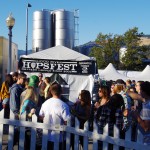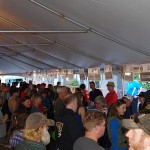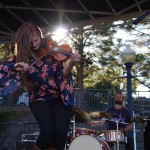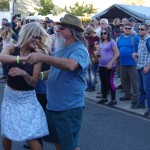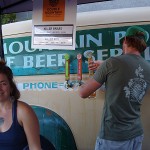The difference between fresh hops and dried hops in beer brewing is like the difference between a mug of Laurelwood Fresh Hop Free Range Red and a bottle of Miller Lite. Unlike conventional beers, tasting a freshly hopped brew is a seasonal experience as the hops’ cone-shaped flower only blooms once a year. The fresh hops need to be trucked to the brewery right away, and the brewery needs to make the necessary adjustments to its equipment. Also called wet-hop beers, these creations utilize hops within 48 hours of their harvest, at which point they are added to the brewing process. The fresh hop contains extra oils and other ingredients that give the finished product a fuller and more floral taste. And the aroma of these brews is worth savoring.
Yesterday, brewers raced their fresh creations to the 12th annual Hood River Fresh Hops Fest at the City Parking Lot between Fifth and Sixth Street, Cascade Avenue and Columbia Street in the heart of Hood River, Oregon, a festival that offered 60 fresh hop beers from three dozen Northwest breweries.
The beers flowed beneath giant white tents, although the pleasant 72-degree didn’t call for the jammed pack environment. It was a tight situation inside the tents, often resulting in a dropped glass mug or two. Most breweries offered two fresh hop beers, pulling down the beer name sign once the keg emptied. Fort George Brewery’s Co-Hoperative Ale went quick.
Most folks grabbed a quick, fresh beer and weaved their way to the music stage, where Bellingham’s Polecat’s edgy, Americana, upbeat, fresh hop, Celtic, reggae, bluegrass had them dancing.
Fresh hop season also brings out the best of brewers’ pun-making tendencies. Some of the most groan-worthy: Amnesia Brewing’s Mother Plucker, GoodLife Brewing’s 150 Hippies, Loowit Brewing’s Judge WOPNA, Sasquatch Brewing’s Fiddy Cent, Stickmen brewing’s Fresh-A-Rillo, Three Creeks Brewing’s Cone Lick’r and Wild Ride Brewing’s Journey to Planet Fresh Hop.
Pale Ales and IPAs weren’t the only freshly hopped styles on display at the Hood River parking lot yesterday. Saisons, Reds, Pilsners, Farmhouse Ales, Kolsch and Marzens made clear that the Pacific Northwest is still the locus of brewing innovation it’s been for the past decade.
A few of my favorite freshies were:
Beer Valley Brewing Company’s Tri-State Fresh Hop Ale went on a three-state bender — pre-funcing with Cascade hops at Obendorf Hop Farm in Idaho, partying with Simcoe hops at Carpenter Ranches in Washing then crashing with Centennial hops at Crosby Hop Farm in Oregon, before kicking it Pale in Hood River.
Breakside Brewery’s Fresh Hop Simcoe IPA, in which the Portland brewery froze fresh Simcoe hops with liquid nitrogen, then used soil tampers to manually splinter the hops. Wow. The complex IPA balances the lavish grapefruit notes of the hops with a fresh, mellow earthiness reminiscent of a farmhouse ale.
Double Mountain Brewery & Taproom’s Killer Green beat out the Hood River brewery’s other two offerings — Killer Red and Killer Brass — due to its herbal notes of mint and oregano with a hint of the Jamaican highland, mon.
Gigantic Brewing Company’s Sodbuster III: Rise of the Simcoe punched my nose with a hop glove then romanced my taste buds with lots of fresh, wet citrusy Simcoe hops from Sodbuster Farms.
Laurelwood Public House & Brewery’s Fresh Hopped Free Range Red is a vividly hoppy American style Red loaded with Cascade hops from Goschie hop farm. It tastes like hops on steroids.
Having a soft spot in my heart for Logsdon Farmhouse Ales after touring the Hood River farm in April, their Fresh Hop Seizoen hasn’t changed my view, with its Citra and citrusy hop character, plus the brewery’s trademark tart and complex fruitiness.
I ended the day with Pfriem Family Brewers’ Fresh Hop Simcoe Pale, a good call with flavors of black current, berries, and pine. This brew finishes resiny, hoppy and oh so, well, fresh!
